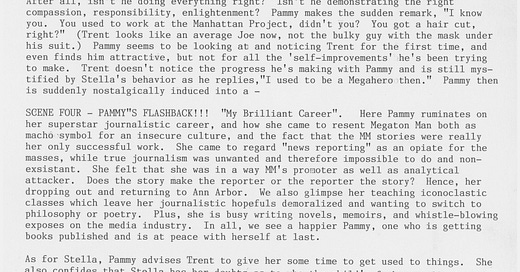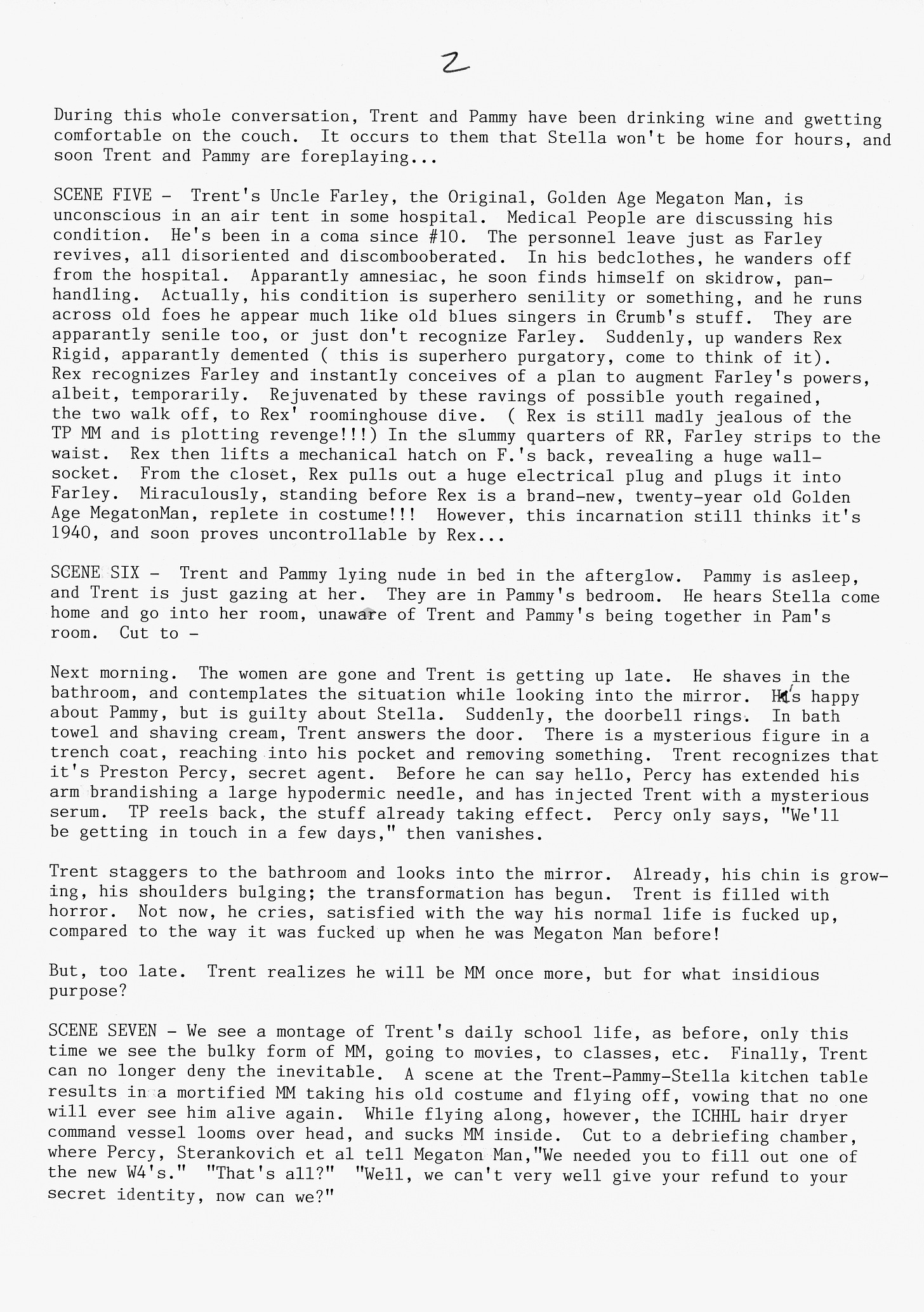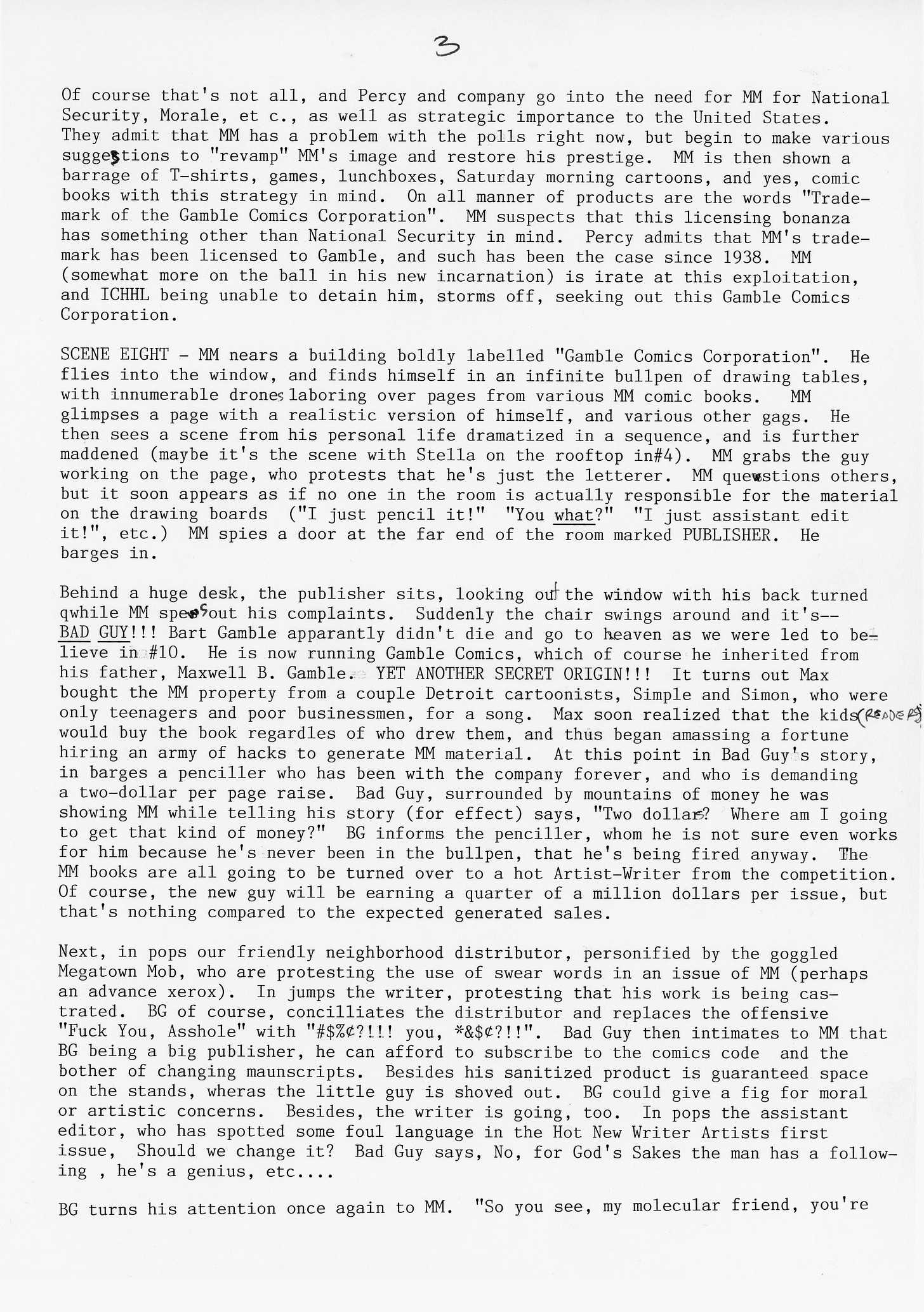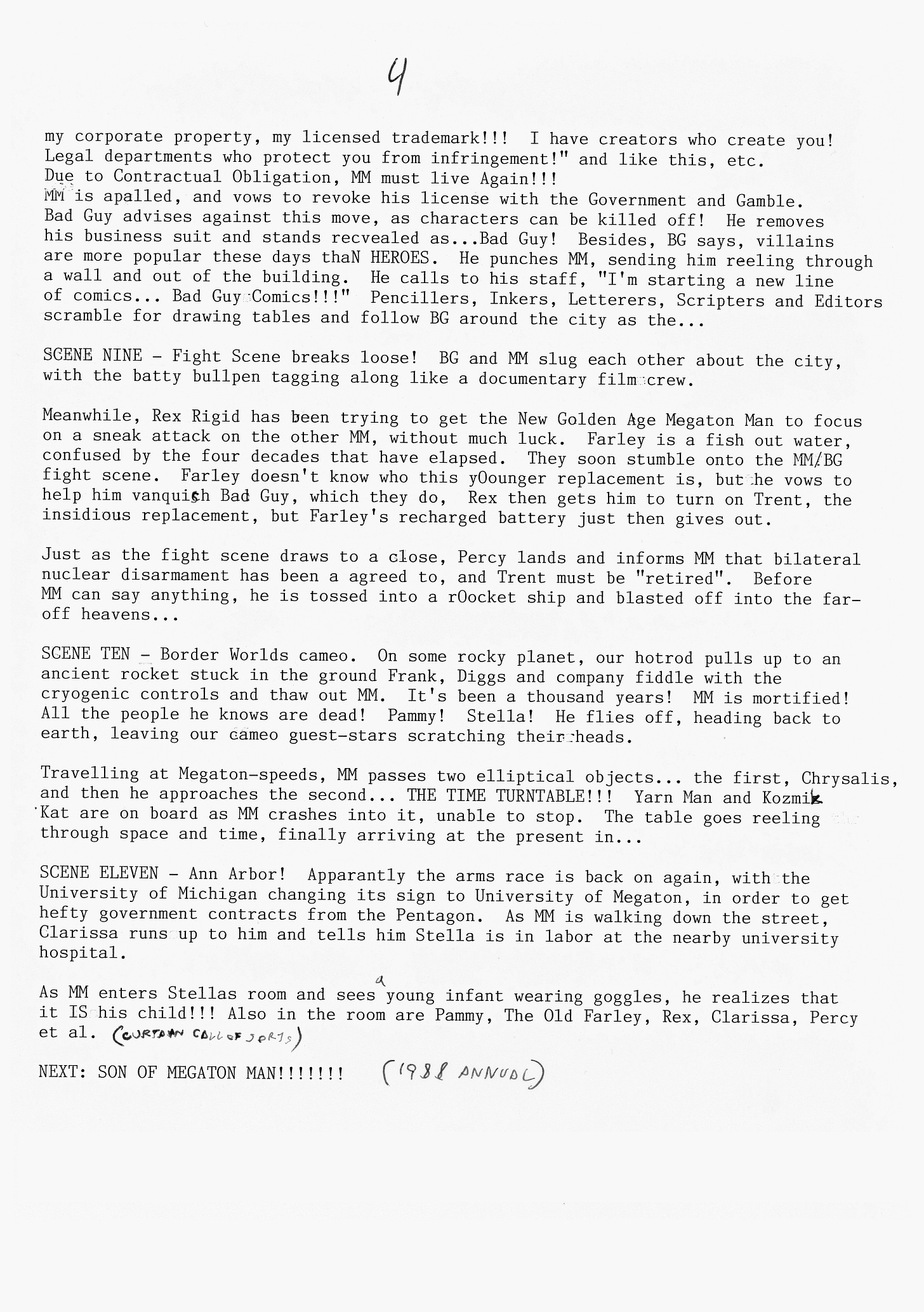Characters Can Always Be Killed Off!
The Plot Outline of Megaton Man #11 and the College-Campus Milieu
The following is taken from a typescript hand-dated January 8, 1987. Originally typed on a Brother electric typewriter without spellchecking, I have newly transcribed it using OCR, and spelling, grammar, and punctuation have been corrected. Also, initials used in place of character names have been spelled out for easier reading, and other slight modifications have been made. Notes and commentary follow below.
Plot Outline—Megaton Man #11
(64-page, color, Baxter paper. $4.50 or whatever)
Scene One—Trent Phloog, anachronistically wearing the Megaton Man goggles, is busy trying to “forget” his past while chopping wood in Pammy and Stella’s backyard on the University of Michigan campus in Ann Arbor (Trent is chopping the wood with his goggle-ray). Pammy and Stella are not home, but Clarissa (last seen in issue #4) is hanging clothes on the laundry line. She advises Trent to desist in cutting wood before every last tree in Michigan is gone. (Exciting splash page!) Trent removes his goggles and remembers that he must forget his past as Megaton Man—he must remember to forget. He stashes the goggles in a bureau in his room inside the house, and we see Stella’s campus-y room, and Pammy’s vacant study. Here, with a normal looking and self-reflexive Trent Phloog, we are led into a …
Scene Two—Flashback! In a nutshell we glimpse issues #1-10 yet again, culminating in Megaton Man’s return to normal due to a side effect of the Cosmic Cue-Ball (hyphenated or not?). Then we see Trent in baggy Megaton Man costume deciding to follow his pregnant girlfriend to Ann Arbor, where Stella is busy going to school and preparing to give birth. She is steadfastly pursuing her education and is prepared to raise the child by herself (the fact that she has a large sum of money from the now-defunct Megatropolis Quartet, Inc., doesn’t hurt.) She lets Trent sleep on the floor in her room, and the scene is not the romantic reunion with family-value overtones that Tretn Phloog had in mind.
Trent enrolls at [the University of] Michigan himself, partaking of the Liberal Arts life, viewing movies, etc., in ironic contradiction to his past life. Yet he still has a conflict: Stella, his responsibility, and Pammy, his desire. In scene one Trent mutters, “I can’t forget her. I can’t put Pammy out of my mind!!!” Clarissa notes: How could he, since she is his roommate?
Scene Three—Stella comes home, in between classes or something, and is too busy to say or do much with Trent. This is to demonstrate the coldness of their relationship. She leaves, and Pammy comes home. Trent turns to Pammy and explains his frustrations. After all, isn’t he doing everything right? Isn’t he demonstrating the right compassion, responsibility, enlightenment? Pammy makes the sudden remark, “I know you. You used to work at the Manhattan Project, didn’t you? You got a haircut, right?” (Trent looks like an average Joe now, not the bulky guy with the mask under his suit.) Pammy seems to be looking at and noticing Trent for the first time, and even finds him attractive, but not for all the “self-improvements” he’s been trying to make. Trent doesn’t notice the progress he’s making with Pammy and is still mystified by Stella’s behavior as he replies, “I used to be a Megahero then.” Pammy then is suddenly nostalgically induced into a …
Scene Four—Pammy’s Flashback!!! “My Brilliant Career.” Here Pammy ruminates on her superstar journalistic career, and how she came to resent Megaton Man both as macho symbol for an insecure culture and the fact that the Megaton Man stories were really her only successful work. She came to regard “news reporting” as an opiate for the masses, while true journalism was unwanted and therefore impossible to do and nonexistent. She felt that she was in a way Megaton Man’s promoter as well as his analytical attacker. Does the story make the reporter or the reporter the story? Hence, her dropping out and returning to Ann Arbor. We also glimpse her teaching iconoclastic classes which leave her journalistic hopefuls demoralized and wanting to switch to philosophy or poetry. Plus, she is busy writing novels, memoirs, and whistle-blowing exposes on the media industry. In all, we see a happier Pammy, one who is getting books published and is at peace with herself at last.
As for Stella, Pammy advises Trent to give her some time to get used to things. She also confides that Stella has her doubts as to who the child’s father really is. During this whole conversation, Trent and Pammy have been drinking wine and getting comfortable on the couch. It occurs to them that Stella won’t be home for hours, and soon Trent and Pammy are foreplaying ...
Scene Five—Trent’s Uncle Farley, the Original, Golden Age Megaton Man, is unconscious in an air tent in some hospital. Medical People are discussing his condition. He’s been in a coma since issue #10. The personnel leave just as Farley revives, all disoriented and discombobulated. In his bedclothes, he wanders off from the hospital. Apparently amnesiac, he soon finds himself on skidrow, panhandling. Actually, his condition is superhero senility or something, and he runs across old foes who appear much like old blues singers in Crumb’s stuff. They are apparently senile too, or just don’t recognize Farley. Suddenly, up wanders Rex Rigid, apparently demented (this is superhero purgatory, come to think of it). Rex recognizes Farley and instantly conceives of a plan to augment Farley’s powers, albeit temporarily. Rejuvenated by these ravings of possible youth regained, the two walk off to Rex’ rooming-house dive. (Rex is still madly jealous of the Trent Phloog-Megaton Man and is plotting revenge!!!) In the slummy quarters of Rex Rigid, Farley strips to the waist. Rex then lifts a mechanical hatch on Farley’s back, revealing a huge wall socket. From the closet, Rex pulls out a huge electrical plug and plugs it into Farley. Miraculously, standing before Rex is a brand-new, twenty-year old Golden Age Megaton Man, replete in costume!!! However, this incarnation still thinks it’s 1940, and soon proves uncontrollable by Rex ...
Scene Six—Trent and Pammy lying nude in bed in the afterglow. Pammy is asleep, and Trent is just gazing at her. They are in Pammy’s bedroom. He hears Stella come home and go into her room, unaware of Trent and Pammy’s being together in Pam’s room. Cut to …
Next morning. The women are gone and Trent is getting up late. He shaves in the bathroom, and contemplates the situation while looking into the mirror. He’s happy about Pammy, but is guilty about Stella. Suddenly, the doorbell rings. In bath towel and shaving cream, Trent answers the door. There is a mysterious figure in a trench coat, reaching into his pocket and removing something. Trent recognizes that it’s Preston Percy, secret agent. Before he can say hello, Percy has extended his arm, brandishing a large hypodermic needle, and has injected Trent with a mysterious serum. Trent reels back, the stuff already taking effect. Percy only says, “We’ll be getting in touch in a few days,” then vanishes.
Trent staggers to the bathroom and looks into the mirror. Already, his chin is growing, his shoulders bulging; the transformation has begun. Trent is filled with horror. Not now, he cries, satisfied with the way his normal life is fucked up, compared to the way it was fucked up when he was Megaton Man before! But, too late. Trent realizes he will be Megaton Man once more, but for what insidious purpose?
Scene Seven—We see a montage of Trent’s daily school life, as before, only this time we see the bulky form of Megaton Man, going to movies, to classes, etc. Finally, Trent can no longer deny the inevitable. A scene at the Trent-Pammy-Stella kitchen table results in a mortified Megaton Man taking his old costume and flying off, vowing that no one will ever see him alive again. While flying along, however, the ICHHL [Ivy-Covered Halls of Higher Learning] hair dryer command vessel looms over head, and sucks Megaton Man inside. Cut to a debriefing chamber, where Percy, Sterankovich, et al, tell Megaton Man, “We needed you to fill out one of the new W4s.” “That’s all?” “Well, we can’t very well give your refund to your secret identity, now can we?”
Of course that’s not all, and Percy and company go into the need for Megaton Man for national security, morale, etc., as well as strategic importance to the United States. They admit that Megaton Man has a problem with the polls right now, but begin to make various suggestions to “revamp” Megaton Man’s image and restore his prestige. Megaton Man is then shown a barrage of T-shirts, games, lunchboxes, Saturday morning cartoons, and yes, comic books with this strategy in mind. On all manner of products are the words “Trademark of the Gamble Comics Corporation.” Megaton Man suspects that this licensing bonanza has something other than National Security in mind. Percy admits that Megaton Man’s trademark has been licensed to Gamble, and such has been the case since 1938. Megaton Man (somewhat more on the ball in his new incarnation) is irate at this exploitation, and ICHHL being unable to detain him, storms off, seeking out this Gamble Comics Corporation.
Scene Eight—Megaton Man nears a building boldly labelled “Gamble Comics Corporation.” He flies in the window and finds himself in an infinite bullpen of drawing tables, with innumerable drones laboring over pages from various Megaton Man comic books. Megaton Man glimpses a page with a realistic version of himself, and various other gags. He then sees a scene from his personal life dramatized in a sequence and is further maddened (maybe it’s the scene with Stella on the rooftop in issue #4). Megaton Man grabs the guy working on the page, who protests that he’s just the letterer. Megaton Man questions others, but it soon appears as if no one in the room is actually responsible for the material on the drawing boards (“I just pencil it!” “You what?” “I just assistant edit it!” etc.) Megaton Man spies a door at the far end of the room marked publisher. He barges in.
Behind a huge desk, the publisher sits, looking out the window with his back turned while Megaton Man spews out his complaints. Suddenly the chair swings around and it’s …
Bad Guy!!! Bart Gamble apparently didn’t die and go to heaven as we were led to believe in issue #10. He is now running Gamble Comics, which of course he inherited from his father, Maxwell B. Gamble; yet another secret origin!!! It turns out Max bought the Megaton Man property from a couple Detroit cartoonists, Simple and Simon, who were only teenagers and poor businessmen, for a song. Max soon realized that the kids (readers) would buy the book regardless of who drew them, and thus began amassing a fortune hiring an army of hacks to generate Megaton Man material. At this point in Bad Guy’s story, in barges a penciler who has been with the company forever, and who is demanding a two-dollar per page raise. Bad Guy, surrounded by mountains of money he was showing Megaton Man while telling his story (for effect) says, “Two dollars? Where am I going to get that kind of money?” Bad Guy informs the penciler, whom he is not sure even works for him because he’s never been in the bullpen, that he’s being fired anyway. The Megaton Man books are all going to be turned over to a Hot Artist-Writer from the competition. Of course, the new guy will be earning a quarter of a million dollars per issue, but that’s nothing compared to the expected generated sales.
Next, in pops our friendly neighborhood distributor, personified by the goggled Megatown Mob, who are protesting the use of swear words in an issue of Megaton Man (perhaps an advance [photocopy]). In jumps the writer, protesting that his work is being castrated. Bad Guy, of course, conciliates the distributor and replaces the offensive “Fuck You, Asshole” with “#$%¢t?!!! you, *&$¢?!!” Bad Guy then intimates to Megaton Man that Bad Guy being a big publisher, he can afford to subscribe to the comics code and the bother of changing manuscripts. Besides, his sanitized product is guaranteed space on the stands, whereas the little guy is shoved out. Bad Guy could give a fig for moral or artistic concerns. Besides, the writer is going; too. In pops the assistant editor, who has spotted some foul language in the Hot New Writer Artist’s first issue. “Should we change it?” Bad Guy says, “No, for God’s sakes, the man has a following, he’s a genius, etc …”
Bad Guy turns his attention once again to Megaton Man. “So you see, my molecular friend, you’re my corporate property, my licensed trademark!!! I have creators who create you! Legal departments who protect you from infringement!” and like this, etc. Due to Contractual Obligation, Megaton Man must live Again!!!
Megaton Man is appalled, and vows to revoke his license with the Government and Gamble. Bad Guy advises against this move, as characters can be killed off! He removes his business suit and stands revealed as … Bad Guy! Besides, Bad Guy says, villains are more popular these days than heroes. He punches Megaton Man, sending him reeling through a wall and out of the building. He calls to his staff, “I’m starting a new line of comics … Bad Guy :Comics!!!” Pencilers, inkers, letterers, scripters and editors scramble for drawing tables and follow Bad Guy around the city as the …
Scene Nine—Fight Scene breaks loose! Bad Guy and Megaton Man slug each other about the city, with the batty bullpen tagging along like a documentary film crew. Meanwhile, Rex Rigid has been trying to get the New Golden Age Megaton Man to focus on a sneak attack on the other Megaton Man, without much luck. Farley is a fish out water, confused by the four decades that have elapsed. They soon stumble onto the Megaton Man – Bad Guy fight scene. Farley doesn’t know who this younger replacement is, but he vows to help him vanquish Bad Guy, which they do. Rex then gets him to turn on Trent, the insidious replacement, but Farley’s recharged battery just then gives out. Just as the fight scene draws to a close, Percy lands and informs Megaton Man that bilateral nuclear disarmament has been a agreed to, and Trent must be “retired.” Before Megaton Man can say anything, he is tossed into a rocket ship and blasted off into the far-off heavens ...
Scene Ten—Border Worlds cameo. On some rocky planet, our hotrod pulls up to an ancient rocket stuck in the ground Frank, Diggs and company fiddle with the cryogenic controls and thaw out Megaton Man. It’s been a thousand years! Megaton Man is mortified! All the people he knows are dead! Pammy! Stella! He flies off, heading back to earth, leaving our cameo guest-stars scratching their·heads. Travelling at Megaton-speeds, Megaton Man passes two elliptical objects … the first, Chrysalis, and then he approaches the second … The Time Turntable!!! Yarn Man and Kozmik Kat are on board as Megaton Man crashes into it, unable to stop. The table goes reeling through space and time, finally arriving at the present in …
Scene Eleven—Ann Arbor! Apparently, the arms race is back on again, with the University of Michigan changing its sign to University of Megaton in order to get hefty government contracts from the Pentagon. As Megaton Man is walking down the street, Clarissa runs up to him and tells him Stella is in labor at the nearby university hospital.
As Megaton Man enters Stella’s room and sees young infant wearing goggles, he realizes that it is his child!!! Also in the room are Pammy, the old Farley, Rex, Clarissa, Percy, et al.
Next: Son of Megaton Man!!!!!!! (1988 annual)
Notes: Despite what I claimed in an earlier post, it would appear that I was contemplating a color Megaton Man #11 on Baxter paper—the format of the first ten issues, although the publisher replied in February of 1987 that he was willing to publish it if I would settle for black and white. How it went from one “annual” to two or four issues and from black and white back to color over the course of the year is unclear; this was likely discussed in undocumented phone conversations—whether with Dave or Denis, I couldn’t say—while I continued working on the final four issues of Border Worlds.
A comparison with The Return of Megaton Man #1, #2, and #3 show a number of interesting alterations, including the omission of the Trent-Pammy lovemaking interlude and the Border Worlds cameo, which would have been wild.
Creatively, what is interesting about this plot is that it represents the most elaborate working out of a Megaton Man story to date. When I was working on the very first issue of Megaton Man—as an unpublished beginner still outside the professional comic book industry—I often made up a page at a time as I went along—sometimes, a panel at a time. Over the course of the ten-issue run, I began to plot (on a legal pad or the back of an envelope) or thumbnail an entire issue out, but it was not more sophisticated than that.
By this time, because of my experience on Border Worlds, which involved a multi-issue story, I was struggling to learn to plot several issues ahead, and while Border Worlds proved a financial disappointment, it was more than worthwhile for the experience gained in making me a better writer, which ultimately benefited the Megaton Man property.
As my thoughts turned to more Megaton Man ideas in January 1987, I was able to conceive and plan out a longer story—in this case, 64 pages or two regular issues of Megaton Man (in most of the ten issues, I averaged at least 30 pages of story plus cover and often inside cover—I did not like the clutter of ads or even letters pages).
Being able to sit at a typewriter and put my thoughts onto paper without resorting to even rough thumbnail sketches marked a dramatic shift in how I approached and planned out comic book stories, one that would continue to evolve in fits and starts down to the present day.
It also enabled me to share my ideas in some coherent form with my editor and publisher and invite comment and critique before production of the artwork. This was a tremendous advancement demonstrating my openness to collaboration and growing sense of security in communicating my ideas. The neurotic artist who could only show inked, finished work was now an author who could run ideas up the flagpole and see if anyone saluted.
Dave Schreiner, as I have noted, applauded the plot and the general direction I was taking, which was more character-driven and less reliant on parodying current fads in comics and the “biz” in general. The publisher, however, does not appear to have made it all the way through the four-page plot.
In retrospect, as I have elaborated upon at length, this plot signaled a second wind for me on Megaton Man and the college-campus milieu potentially rich in story possibilities. Although nothing beyond the 64-pages is suggested, one can infer that the new baby would keep Stella, Trent, and company occupied in Ann Arbor for many years to come—with bizarre interventions from old megahero friends, UFOs, secret agents, hippies, tenured radicals, Pentagon-funded lab experiments, and so forth.
I have commented in prior posts how discussions turned acrimonious when the publisher insisted on renumbering Megaton Man #11 with a new #1, which I considered reneging on his commitment and throwing unnecessary obstacles in the way—it was a feckless gimmick that would backfire in the long run. One is free to regard this as simply a “business” or marketing dispute, but I assert it had creative repercussions.
The worst outcome is that I never permitted my mind to go further with the college-campus milieu. There are some glimpses of it in later one-shots, but with the publisher demanding almost the complete opposite formula from what my editor had, vis-à-vis character-driven plot versus event-driven superhero parody, something had to give.

When I was free of Kitchen Sink Press in the early nineties, and began work on Don Simpson’s Bizarre Heroes, the college-campus storyline by then seemed rather quaint. I associated much of my time spent in Ann Arbor, when I lived in Detroit, and Madison, when I lived in Wisconsin at the publisher’s compound, with Kitchen Sink Press itself, and with that happy first year-and-a-half or two as a professional cartoonist. Ann Arbor and Madison, both oases in the middle of forested and cultivated rural land, had much the same vibe for me.
After the acrimony of Megaton Man #11, and what I took as a tacit rejection of my college-campus milieu, I never felt the same fondness for the publisher or for the setting that I so associated with underground comix and counterculture. I had moved to Pittsburgh at the end of 1986, and gravitated immediately to the Oakland section of the city, home of Carnegie-Mellon and the University of Pittsburgh—but these urban college campuses, while certainly offering culture, just weren’t the same.
Although the Megaton Man cast inevitably hijacked Bizarre Heroes, it really wasn’t until The Megaton Man Weekly Serial, the online web strip I created from 1996 to 2001, that I felt my innate fondness for Megaton Man—the character himself—fully return, and it wasn’t until after I completed my own return to college in the late twenty-teens (which involved visits to Berkeley, Columbus, and Yale as well as Ann Arbor for dissertation research) that I began to reconnect with the college-campus milieu plot ideas for Megaton Man I had effectively shelved in the late 1980s.
In The Ms. Megaton Man Weekly Serial prose series, I finally found an inroad to utilize some of those ideas—reconstructed and reinvented, of course, but without violating any of the “facts” or continuity established in the published comics. I will discuss this long, winding path back to the “University of Megaton” in future posts.







